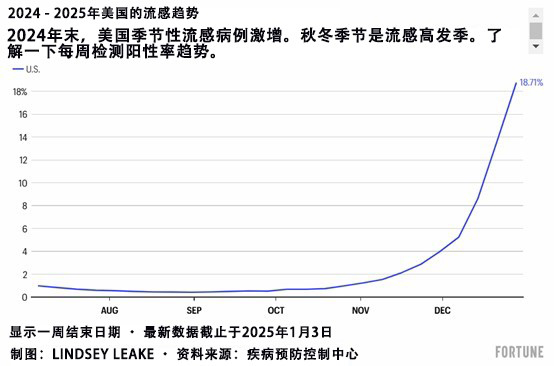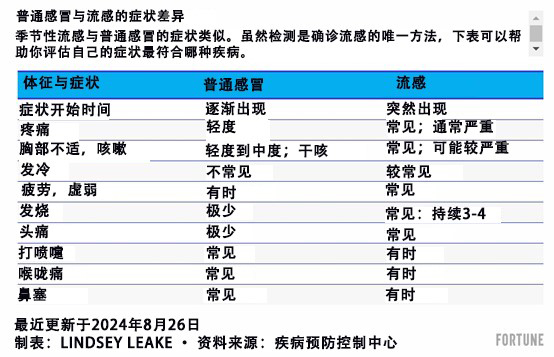
又到了1月份,。新年伊始,,寒風呼嘯,呼吸道感染疾病頻發(fā),。隨著流感,、新冠病毒、呼吸道合胞病毒(RSV)和胃腸道疾病諾如病毒這四種病毒在全美傳播,,你很難確定自己的病因到底是什么,。再加上普通感冒,,你會產(chǎn)生一系列類似的癥狀,。
當前正是流感高發(fā)季。根據(jù)美國疾病預(yù)防控制中心(Centers for Disease Control and Prevention ,,CDC)的數(shù)據(jù),,截至去年12月28日當周,全美流感檢測陽性率達到了18.7%的季節(jié)性高點,,而六周前這一數(shù)字僅為2.1%,。此外,在該機構(gòu)監(jiān)測的所有10個地區(qū)的流感樣疾病活動都有所上升,。那么,,如何確定自己得了流感呢?
與感染新冠一樣,,檢測是確診是否感染流感病毒的唯一方法,。然而,疾控中心指出,,醫(yī)生可能僅根據(jù)患者的癥狀進行診斷,。更準確的流感檢測方法,,如逆轉(zhuǎn)錄-聚合酶鏈式反應(yīng)(RT-PCR)、病毒培養(yǎng)和熒光免疫檢測等,,需要醫(yī)療保健人員在患者喉嚨深處或鼻腔內(nèi)部進行拭子采樣,,然后將拭子送到專業(yè)實驗室。
而流感快速診斷檢測(RIDT)和快速分子檢測雖然準確度較差,,但更容易操作,。在許多藥店、大賣場和在線零售商處都能買到RIDT檢測產(chǎn)品,。如果你無法自行檢測,,急診中心、醫(yī)療檢測機構(gòu)和其他診所都可以為你進行檢測,,在10到20分鐘內(nèi)就能得到結(jié)果,,具體時間取決于檢測類型。
一些非處方檢測產(chǎn)品和實驗室檢測可以在一個樣本中區(qū)分出新冠病毒,、甲型流感病毒,、乙型流感病毒和/或呼吸道合胞病毒。雖然同時患流感和其他呼吸道疾病的可能性是存在的,,但疾控中心表示尚不清楚這種情況的普遍性,。

流感有哪些癥狀?
知道自己是否患有某種呼吸道疾病不僅有助于公共衛(wèi)生官員追蹤疾病傳播情況,,還能幫助醫(yī)療保健人員為你確定最佳治療方案,。疾控中心指出,如果你有以下癥狀,,你可能需要考慮進行流感檢測:
? 咳嗽
? 疲勞
? 發(fā)燒或感覺發(fā)燒/發(fā)冷(并非所有人都會發(fā)燒)
? 頭痛
? 肌肉痛或身體疼痛
? 流鼻涕或鼻塞
? 喉嚨痛
? 嘔吐和腹瀉(兒童更常見癥狀)

哪些流感癥狀需要緊急就醫(yī),?
大多數(shù)人感染流感后僅有上述輕微癥狀,并且無需使用抗病毒處方藥即可自行康復(fù),。然而,,對老年人、幼兒以及哮喘,、肥胖癥和心臟病等病癥的患者來說,,流感仍然可能引發(fā)重癥甚至致命。
洛杉磯西達賽奈醫(yī)療中心(Cedars-Sinai Medical Center)的醫(yī)院流行病學副醫(yī)療主任邁克爾·本-阿德雷特博士此前對《財富》雜志表示:“美國每年有成千上萬的患者因流感住院和死亡,,特別是老年人或其他疾病的患者,。對這些人和其他所有人來說,最好接種流感疫苗,?!?/p>
如果你或你照顧的人出現(xiàn)以下任何流感并發(fā)癥的跡象,疾控中心建議緊急就醫(yī):
? 成年人
o 呼吸困難或氣短
o 發(fā)燒或咳嗽好轉(zhuǎn)后復(fù)發(fā)或惡化
o 無尿
o 持續(xù)頭暈、意識不清,、無法喚醒
o 胸腹部持續(xù)疼痛或壓迫感
o 驚厥
o 嚴重肌肉疼痛
o 嚴重虛弱或不穩(wěn)
o 慢性病惡化
? 兒童
o 12周以下兒童發(fā)燒
o 嘴唇或臉色發(fā)青
o 胸痛
o 脫水(8小時無尿,、口干、哭泣時無淚)
o 呼吸急促或呼吸困難
o 高燒超過104華氏度,,且退燒藥無效
o 發(fā)燒或咳嗽好轉(zhuǎn)后復(fù)發(fā)或惡化
o 清醒時反應(yīng)遲鈍或沒有正?;?/p>
o 每次呼吸時肋骨內(nèi)陷
o 驚厥
o 嚴重肌肉疼痛(孩子拒絕走路)
o 慢性病惡化
1月份接種流感疫苗是否為時已晚?
美國國家傳染病基金會(National Foundation for Infectious Diseases)的醫(yī)療主任羅伯特·霍普金斯博士表示,,簡單來說,,一點都不晚。
霍普金斯在12月份對《財富》雜志表示:“根本不晚,。當未來面臨風險時,,任何時候接種疫苗都是有益的。我當然希望人們能更早接種疫苗,,但我不會為了追求完美而忽視任何時候接種疫苗的好處,。”
盡管2024至2025年的季節(jié)性流感疫苗不能預(yù)防H5N1禽流感,,但疾控中心表示,,接種疫苗的人越多,當前的禽流感爆發(fā)成為大流行的可能性就越低,。這是因為兩種類型的流感可能交換遺傳物質(zhì),,形成一種新的流感病毒,并在人類中傳播,。
然而,,今年流感季的疫苗接種覆蓋率一直不足。截至去年12月28日當周,,只有不到一半的成年人(42.7%)接種了年度流感疫苗,,兒童的比例也相差無幾(41.9%)。(財富中文網(wǎng))
譯者:劉進龍
審校:汪皓
又到了1月份,。新年伊始,,寒風呼嘯,,呼吸道感染疾病頻發(fā),。隨著流感、新冠病毒,、呼吸道合胞病毒(RSV)和胃腸道疾病諾如病毒這四種病毒在全美傳播,,你很難確定自己的病因到底是什么。再加上普通感冒,,你會產(chǎn)生一系列類似的癥狀,。
當前正是流感高發(fā)季。根據(jù)美國疾病預(yù)防控制中心(Centers for Disease Control and Prevention ,CDC)的數(shù)據(jù),,截至去年12月28日當周,,全美流感檢測陽性率達到了18.7%的季節(jié)性高點,而六周前這一數(shù)字僅為2.1%,。此外,,在該機構(gòu)監(jiān)測的所有10個地區(qū)的流感樣疾病活動都有所上升。那么,,如何確定自己得了流感呢,?
與感染新冠一樣,檢測是確診是否感染流感病毒的唯一方法,。然而,,疾控中心指出,醫(yī)生可能僅根據(jù)患者的癥狀進行診斷,。更準確的流感檢測方法,,如逆轉(zhuǎn)錄-聚合酶鏈式反應(yīng)(RT-PCR)、病毒培養(yǎng)和熒光免疫檢測等,,需要醫(yī)療保健人員在患者喉嚨深處或鼻腔內(nèi)部進行拭子采樣,,然后將拭子送到專業(yè)實驗室。
而流感快速診斷檢測(RIDT)和快速分子檢測雖然準確度較差,,但更容易操作,。在許多藥店、大賣場和在線零售商處都能買到RIDT檢測產(chǎn)品,。如果你無法自行檢測,,急診中心、醫(yī)療檢測機構(gòu)和其他診所都可以為你進行檢測,,在10到20分鐘內(nèi)就能得到結(jié)果,,具體時間取決于檢測類型。
一些非處方檢測產(chǎn)品和實驗室檢測可以在一個樣本中區(qū)分出新冠病毒,、甲型流感病毒,、乙型流感病毒和/或呼吸道合胞病毒。雖然同時患流感和其他呼吸道疾病的可能性是存在的,,但疾控中心表示尚不清楚這種情況的普遍性,。
流感有哪些癥狀?
知道自己是否患有某種呼吸道疾病不僅有助于公共衛(wèi)生官員追蹤疾病傳播情況,,還能幫助醫(yī)療保健人員為你確定最佳治療方案,。疾控中心指出,如果你有以下癥狀,,你可能需要考慮進行流感檢測:
? 咳嗽
? 疲勞
? 發(fā)燒或感覺發(fā)燒/發(fā)冷(并非所有人都會發(fā)燒)
? 頭痛
? 肌肉痛或身體疼痛
? 流鼻涕或鼻塞
? 喉嚨痛
? 嘔吐和腹瀉(兒童更常見癥狀)
哪些流感癥狀需要緊急就醫(yī),?
大多數(shù)人感染流感后僅有上述輕微癥狀,并且無需使用抗病毒處方藥即可自行康復(fù)。然而,,對老年人,、幼兒以及哮喘、肥胖癥和心臟病等病癥的患者來說,,流感仍然可能引發(fā)重癥甚至致命,。
洛杉磯西達賽奈醫(yī)療中心(Cedars-Sinai Medical Center)的醫(yī)院流行病學副醫(yī)療主任邁克爾·本-阿德雷特博士此前對《財富》雜志表示:“美國每年有成千上萬的患者因流感住院和死亡,特別是老年人或其他疾病的患者,。對這些人和其他所有人來說,,最好接種流感疫苗?!?/p>
如果你或你照顧的人出現(xiàn)以下任何流感并發(fā)癥的跡象,,疾控中心建議緊急就醫(yī):
? 成年人
o 呼吸困難或氣短
o 發(fā)燒或咳嗽好轉(zhuǎn)后復(fù)發(fā)或惡化
o 無尿
o 持續(xù)頭暈、意識不清,、無法喚醒
o 胸腹部持續(xù)疼痛或壓迫感
o 驚厥
o 嚴重肌肉疼痛
o 嚴重虛弱或不穩(wěn)
o 慢性病惡化
? 兒童
o 12周以下兒童發(fā)燒
o 嘴唇或臉色發(fā)青
o 胸痛
o 脫水(8小時無尿,、口干、哭泣時無淚)
o 呼吸急促或呼吸困難
o 高燒超過104華氏度,,且退燒藥無效
o 發(fā)燒或咳嗽好轉(zhuǎn)后復(fù)發(fā)或惡化
o 清醒時反應(yīng)遲鈍或沒有正?;?/p>
o 每次呼吸時肋骨內(nèi)陷
o 驚厥
o 嚴重肌肉疼痛(孩子拒絕走路)
o 慢性病惡化
1月份接種流感疫苗是否為時已晚?
美國國家傳染病基金會(National Foundation for Infectious Diseases)的醫(yī)療主任羅伯特·霍普金斯博士表示,,簡單來說,,一點都不晚。
霍普金斯在12月份對《財富》雜志表示:“根本不晚,。當未來面臨風險時,,任何時候接種疫苗都是有益的。我當然希望人們能更早接種疫苗,,但我不會為了追求完美而忽視任何時候接種疫苗的好處,。”
盡管2024至2025年的季節(jié)性流感疫苗不能預(yù)防H5N1禽流感,,但疾控中心表示,,接種疫苗的人越多,當前的禽流感爆發(fā)成為大流行的可能性就越低,。這是因為兩種類型的流感可能交換遺傳物質(zhì),,形成一種新的流感病毒,并在人類中傳播,。
然而,,今年流感季的疫苗接種覆蓋率一直不足,。截至去年12月28日當周,,只有不到一半的成年人(42.7%)接種了年度流感疫苗,兒童的比例也相差無幾(41.9%)。(財富中文網(wǎng))
譯者:劉進龍
審校:汪皓
Ah, January. The season of new beginnings, icy winds, and respiratory infections. With a “quad-demic” of diseases circulating the country—flu, COVID, respiratory syncytial virus (RSV), and norovirus, a gastrointestinal illness—it can be difficult to be sure which is making you sick. Throw in the common cold, and you’ve got a symphony of similar symptoms.
The flu is having a moment. Nationwide test positivity was at a season-high 18.7% the week ended Dec. 28, compared to 2.1% six weeks earlier, according to the Centers for Disease Control and Prevention (CDC). What’s more, influenza-like illness activity was elevated in all 10 regions the agency surveils. So how can you be sure you have the flu?
As with COVID, testing is the only way to confirm the presence of the influenza virus in your body. However, the CDC notes that your doctor may diagnose you based on your symptoms alone. The more accurate flu tests—reverse transcription polymerase chain reaction (RT-PCR), viral culture, and immunofluorescence assays—require a health care provider to swipe the back of your throat or the inside of your nose, then send the swab to a specialized lab.
While less accurate, rapid influenza diagnostic tests (RIDTs) and rapid molecular assays are more accessible. You can purchase an RIDT over the counter at a number of pharmacies, big-box stores, and online retailers. If you’re unable to complete such testing on your own, urgent care centers, medical testing facilities, and other clinics can do it for you and provide results within 10 to 20 minutes, depending on the type of test.
Some over-the-counter and laboratory tests can differentiate between COVID, influenza A, influenza B, and/or RSV in a single sample. It’s also possible to have flu and another respiratory illness at the same time, though the CDC says it’s unclear how common this is.
What are the symptoms of the flu?
Knowing which respiratory illness you do or don’t have not only assists public health officials in tracking disease spread, but also helps your health care provider determine the best course of treatment for you. You might consider flu testing if you have the following symptoms, as noted by the CDC:
? Cough
? Fatigue
? Fever or feeling feverish/chills (not everyone will have a fever)
? Headaches
? Muscle or body aches
? Runny or stuffy nose
? Sore throat
? Vomiting and diarrhea (more common in children)
Which flu symptoms require emergency care?
Most people who catch the flu have only the above mild symptoms and recover on their own without the use of antiviral prescription medication. Still, flu can be serious and even deadly for older adults, young children, and people with certain conditions including asthma, obesity, and heart disease.
“Every year in this country we have thousands and thousands of patients who are hospitalized and die with influenza, and they are particularly older people or people with medical illness,” Dr. Michael Ben-Aderet, associate medical director of hospital epidemiology at Cedars-Sinai Medical Center in Los Angeles, previously told Fortune. “It is beneficial to those people and everyone else that we get the flu vaccine.”
If you or a person in your care shows any of the following signs of flu complications, the CDC recommends seeking emergency medical care:
? Adults
o Difficulty breathing or shortness of breath
o Fever or cough that improves but then returns or worsens
o Not urinating
o Persistent dizziness, confusion, inability to arouse
o Persistent pain or pressure in the chest or abdomen
o Seizures
o Severe muscle pain
o Severe weakness or unsteadiness
o Worsening of chronic medical conditions
? Children
o Any fever in children younger than 12 weeks
o Bluish lips or face
o Chest pain
o Dehydration (no urine for 8 hours, dry mouth, no tears when crying)
o Fast breathing or trouble breathing
o Fever above 104 degrees that’s not controlled by fever-reducing medicine
o Fever or cough that improves but then returns or worsens
o Not alert or interacting when awake
o Ribs pulling in with each breath
o Seizures
o Severe muscle pain (child refuses to walk)
o Worsening of chronic medical conditions
Is January too late to get the flu shot?
In a word, no, says Dr. Robert Hopkins Jr., medical director of the National Foundation for Infectious Diseases.
“It’s not too late,” Hopkins told Fortune in December. “It is not a bad time when we’ve got risk in front of us. And I would certainly prefer that people were vaccinated earlier, but I’m not going to make perfection the enemy of the good.”
And while the 2024–25 seasonal flu vaccine doesn’t protect against H5N1 bird flu, the more people who get the vaccine, the lower the chances of the current bird flu outbreak becoming a pandemic, the CDC says. That’s because it’s possible for the two flu types to exchange genetic material, forming a new flu virus that could spread among humans.
Yet vaccination coverage this season has been lacking. Less than half of adults (42.7%) had gotten their annual flu shot as of the week ended Dec. 28, as had about the same proportion of children (41.9%).






